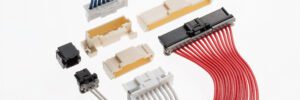
Phoenix Contact Group is made up of 15 German and four international companies, along with 11 manufacturing locations, and has a footprint in more than 100 countries. The 99-year-old company offers creative solutions in the fields of connection technology, electronics and automation and is independent in its entrepreneurial and decision-making freedom. Phoenix Contact’s core business areas include device connectors, industrial components and electronics, and industry management and automation.
Over the last decade, Phoenix Contact has invested in new business fields as well, with a future vision of an all-electric society through the transformation of the mobility sector to electric mobility. This includes an e-mobility headquarters in Germany that serves as its center of expertise in the field of charging technology where Phoenix Contact develops and manufactures components and solutions for charging infrastructure as well as vehicle charging interfaces. In the beginning of 2022, Phoenix Contact established a new team within the U.S. subsidiary focusing on the e-mobility infrastructure market.
Phoenix Contact’s longevity, expertise and investment in the all-electric society positions them as an expert on electric mobility market trends and behaviors. Currently, we are living in the world of traditional refueling at central, exclusive locations. Customers wait to head to fueling stations until the tank is almost empty, when fuel prices are low, or when the vehicle’s fuel level is not enough for a longer trip.
In a world with widespread electric vehicle adoption and adequate charging infrastructure, customers could charge at nearly any location and any time, not only when the battery level is too low for planned travel. This approach – called opportunity charging – will integrate fueling into daily life as the ability to charge a vehicle anywhere increases.
This change of behavior is already reflected in the outlook of electric vehicles worldwide: over the next decade, the internal combustion engine in new vehicles will increasingly be replaced with plug-in hybrids or pure electric vehicles. Current studies also show a clear trend in favor of battery electric vehicles over plug-in hybrid vehicles, making the outlook for charging points worldwide even more attractive. The development of infrastructure supported by various state-specific laws, incentives, and recognition of climate change is at the forefront of the industry.
E-MOBILITY CHARGING COMPONENTS
Phoenix Contact has a broad variety of products that complement the building of e-mobility infrastructure and charging stations, including terminal blocks, connectors, power supplies and protection components. These products are specifically designed for e-mobility, such as charging cables, controllers, inlets, auxiliary power, and other electronics.
When it comes to the general application of a point-of-use charger at the vehicle, larger electronics are needed for high-power sources. These types of chargers will pull from the power grid, so the charger needs to step the power output down to 480 volts and convert it to DC power – regardless of whether the power is being used to charge battery banks, for peak shaving, or going straight to the charging device.
Inside the charging cabinet includes controllers, monitoring information, and terminal blocks, as well as all the actual power converters. Phoenix Contact is developing its portfolio of products for specific e-mobility applications under the Power Brand name. This includes AC input and DC input power supplies, which use push-in and T-LOX connection technology and are galvanically isolated – they are electrically isolated from input to output, which helps reduce noise. The power supplies meet standards for urban infrastructure and are ready to use inside an IP54 cabinet.
The DC input is also ready to be used with maximum power point tracking (MPPT) for solar applications. Throughout the day, solar applications receive irregular exposure to the sun through different panels, causing both solar radiation and temperature to fluctuate and resulting in a constantly-changing output. Therefore, technology is needed in the power source to track how the array is creating power and adapt the voltage and current to give the best possible output for the DC voltage.

ADVANCES IN CHARGING SYSTEM DESIGN
On Phoenix Contact’s roadmap is a new solution that will help simplify charging points – a control system that pairs with CHARX power modules. Whether it’s a point-of-sale charging station where the customer needs to pay for the energy or an industrial charger, additional equipment is required. This includes components such as touch panels with RFID or near-field communication capabilities and connections for point-of-sale interfaces, as well as CCS cables, energy meters, DC connectors, high-voltage fuses and various sensors.
Currently, these cabinets have a larger footprint and require complex wiring and high-effort cabling that increase the potential for failures at the assembly. Phoenix Contact’s CHARX power control box builds all the charging components into one rack-mount housing that is installed above the power source. This universal solution requires minimal integration effort in a 19” standardized installation. Other thoughtful design elements include integrated charging control, auxiliary power, overvoltage protection and simple connections thanks to push-in technology.

APPLICATIONS
The most prevalent application of CHARX power modules is within the charging stations used to charge electric vehicles, whether they are passenger cars, buses, or even off-highway applications such as heavy earth moving equipment. Power modules can also be used in mobile power supplies, DC industries, electrolysis, and peak shaving.
New electric vehicle trends are rapidly emerging, and the charging infrastructure needed to enable their adoption must evolve as well. For example, Ford has recently introduced its new Lightning F150 electric pickup truck, which offers bidirectional power flow – the truck can be used to power a house if the power goes out. These types of bidirectional electronics require the ability to not only feed from the grid battery and through the charger to a vehicle but a reverse power flow, as well.
As an established organization offering industry-shaping solutions, Phoenix Contact is leading the way in streamlining current e-mobility infrastructure and preparing for the innovations on the horizon. To learn more, visit www.phoenixcontact.com/charx or search for “Phoenix Contact e-mobility” on YouTube.
from Charged EVs https://ift.tt/IFBWiec


No comments:
Post a Comment